Hiking with preschool-aged kids and bigger kids can be a challenge. On one hand, they should be able to hike alongside you. But kids also suddenly get tired, cranky and refuse to hike another step (bribing with gummy bears only works to a point!). And let’s not forget about hiking with kids with disabilities or special needs.
Luckily, there are some hiking carriers for bigger kids. These include framed carriers, soft carriers, hiking strollers, wagons, piggyback carriers and some newer options.
Admittedly, none of these hiking carriers is perfect. They all have major downsides and limitations. And, even in the best child carrier, lugging a 40lbs kid is still going to be a challenge! But these solutions are probably better than trying to carry a kid in your arms while hiking. I’ll go over the options here and their pros/cons so you can figure out which one makes most sense for your family.
Also read: How far can kids hike?
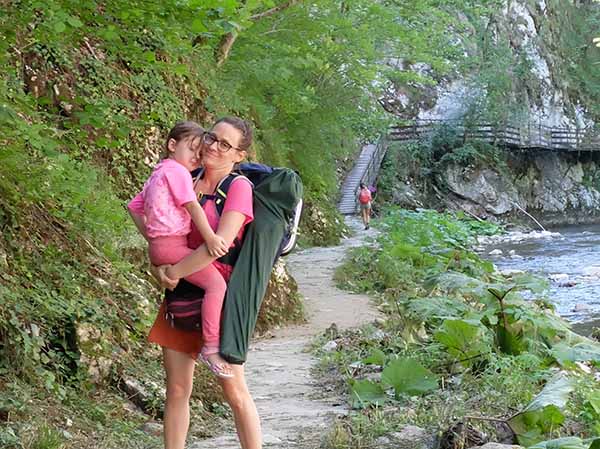
Carrying my 40lb kid in my arms on a recent short hike — NOT fun or safe!!!
1. Framed Backpack Carriers
Most framed backpack child carriers have weight limits of 45-50lbs, which means they are suitable for carrying kids of up to 5 or 6 years old. The Deuter Kid Comfort is by far the most popular (available at Amazon and REI). It even comes in sizes for petite women.
Pros:
- Load distribution: When it comes to load distribution, these hiking carriers are by far the best option. The frame and hip belt help distribute the weight, saving your back and shoulders.
- Comfort for carrier: In addition to distributing load, framed child carriers usually have padded straps and sternum straps to stop wobbling. This makes them very comfortable to wear, even for long hikes.
- Storage and features: Good framed child carriers have pockets for storing gear. Some have other cool features like mirrors so you can check on your child, sun canopies and more.
Cons:
- Getting it on is a pain: Even when my kid was only 30lbs, I found it very difficult to get the framed carrier onto my back. Your kid has to climb into it and then you use all your upper body strength to swing it onto your back. It’s easier if you have a partner to help you lift it onto your back. This isn’t too annoying if your kid stays in the carrier for the entire hike. But it’s really annoying if you’ve got a kid who wants to get in/out every 10 minutes!
- They are bulky and heavy:Framed child carriers are heavy – usually around 6-7lbs. And they are very large and bulky. If you are only bringing it as a backup just in case your kid needs a break, it’s annoying to carry around for the entire hike.
- Big kids might not fit: Just because your kid is within the weight limit, it doesn’t mean your kid will fit in the carrier. When my daughter was 3, she barely fit in our framed carrier during colder months when she had her puffy jacket on. The tight fit can make the carrier uncomfortable for big kids.
- The good ones are EXPENSIVE: There are cheap framed hiking carriers, but they usually aren’t as comfortable and do a poor job distributing load. Expect to shell out a couple hundred for a decent framed carrier.
2. Trail Magik Carrier
This is a brand new type of hiking carrier specifically designed for bigger kids (ages 2 to 4). It attaches to your backpack with clips and carabiners. It’s insanely cool and suitable for kids from 1 year old to 43lbs. You can get it here – Use discount code MOMGOES for 10% off. Or read my full review of the Trail Magik carrier.
Pros:
- Insanely lightweight and small: Because the Trail Magik carrier attaches to your backpack, it doesn’t need to have its own shoulder straps or hip belt. This makes it the lightest and smallest child carrier for toddlers and little kids available. It weighs only 9.8oz and folds down smaller than a water bottle!
- Suitable for multi-day backpacking trips: If you want to do some serious backpacking with a little kid, this is probably the best option. You will be able to carry your kid along with whatever gear you have on your back.
- Easy to get your kid in/out: Compared to all the other options (aside from wagons), this is the easiest carrier to get your child in and out of. That makes it great for hiking with little kids who need lots of short breaks.
Cons:
- Front carry only: If your kid is tall, they might block your view.
- Not very comfy for the carrier: Hiking with 40lbs on your front isn’t exactly comfortable. And you’ve got to be a superhero to carry a heavy kid on your front and a heavy pack on your back!
3. Hiking Strollers
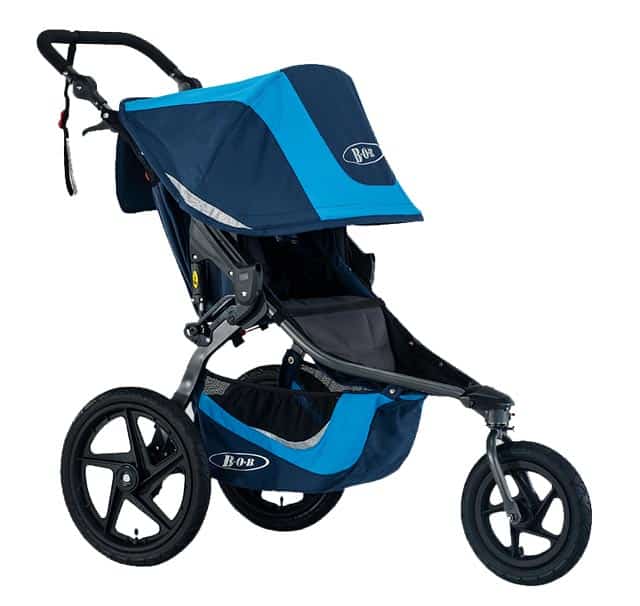
Unlike normal strollers or even joggers, hiking strollers have large wheels and suspension systems. These features allow them to go off-road, even on some tough terrain, without jostling your kid or causing wrist strain. The BOB Revolution Flex 3.0 is one of the best (available at Amazon). Also read: Best Hiking Strollers Compared
Pros:
- Save your back: Don’t like the idea of carrying your heavy kid on your back hiking? Some hiking strollers can carry kids up to 70lbs!
- Can put other gear in there too: While you are at it, put lots of gear in the stroller’s storage basket. You’ll be able to bring along lots of stuff without having to carry any of it on your back.
- Kids can nap in there: While kids can theoretically nap in framed carriers, it isn’t very comfortable. Hiking strollers are best for nap time during hikes.
- Rain and sun protection: Good hiking strollers have UV protection and water-resistant canopies (some are completely waterproof).
Cons:
- Not for really tough terrain: While hiking strollers can go off-road and on dirt paths, you’ve got to be realistic about where they can go. They are terrible on narrow paths or anywhere very rocky.
- Expensive: A good hiking stroller can cost well over $500. This might make sense if you buy it when your kid is a baby or are having another kid, but not if your child is already older.
- Take up tons of space: Even with the wheels off, hiking strollers are massive. They might not fit in your car trunk!
- Height limits: Pay attention to the height limits on hiking strollers. Even if your kid is within the weight limit, they might be too tall for the stroller.
*Random tip: I sometimes used a stroller and a carrier for hiking. When the terrain got too tough for the stroller, I’d lock it to a tree and switch my kid to a carrier.
4. Folding Hiking Wagons
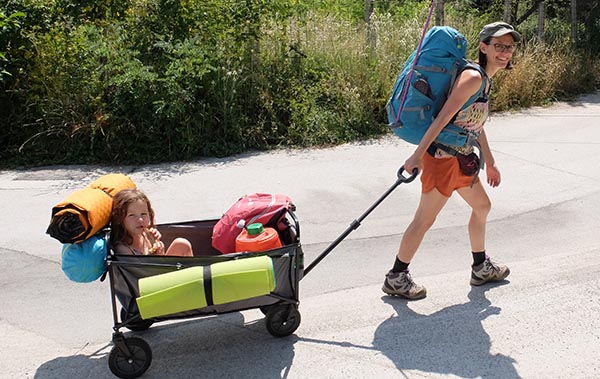
I tested this out on a backpacking trip with kid when she was 4 years old. There was about 5 miles of walking on a smooth path to get to our camping spot. My daughter loved getting a ride in the wagon. I was also able to load tons of other stuff into it, like a massive water jug. Some hiking wagons have weight limits of over 150lbs! You can see I strapped loads of other gear to the sides (but still ended up carrying tons on my back, ha! :))
Pros:
- Solution for very big kids or two kids: Because of the high weight limit, you can use a hiking wagon for big kids (such as kids with special needs). There aren’t any height limits to worry about in a wagon either.
- Carry other gear too: Go ahead and load lots of gear in the wagon. I even strapped bulky items like sleeping pads and a tent to the outside of the wagon frame. Since your kid is in the wagon, it also means you can wear whatever backpack you want.
- Easy on your back: This is definitely better than carrying a kid when hiking! Some even give you the option for pulling or pushing.
- Kids can get in/out easily: You don’t have to stop and do any weird manuevering if your kid feels like walking.
Cons:
- Only suitable for smooth terrain: The ride gets bumpy the moment you get on unpaved roads or paths. This will really limit where you can use a hiking wagon.
- Most are really expensive: Expect to pay at least $150 for a good hiking wagon. The Veer wagon (which is badass) costs nearly $700! If you don’t have other uses for it (like for gardening or shopping), then it might not be worth the investment.
Also read: Best Hiking Wagons
5. Wrap Carriers
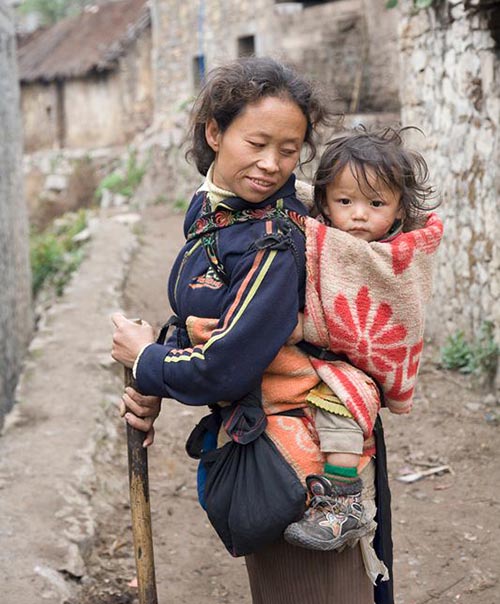
Wrap child hiking carriers work by wrapping a bunch of fabric around your child and yourself. Some have very high weight limits and come in sizes suitable for all ages of children. A lot of indigenous people carry their kids in wraps and there are lots of ways to make them.
Pros:
- Packable: Because they are smallish and lightweight, they are easy to shove in a backpack and take out “just in case” your kid needs a break.
- Front or back carry: Which means you can wear a backpack and carry your kid at the same time. Or even carry two kids at once.
- Versatile: Wraps also double as a picnic blanket, scarf, towel, pillow, improvised bandage for injuries…
Cons:
- Poor load distribution: Compared to framed carriers, wrap carriers aren’t going to distribute weight well. Even if you use some fancy wrap that goes around your waist, most of the load will still end up on your shoulders and back.
- Somewhat annoying to put on: I personally don’t mind the wrapping. However, because most consist of very long pieces of fabric, it’s almost impossible to put them on without getting the fabric on the ground – a major problem if the ground is muddy or wet!
6. Piggyback Carriers
Piggyback carriers are basically a harness which has a bar on it. Your child stands on the bar to get a ride. I personally haven’t tried these but most hikers do not like them.
Pros:
- Fairly light and compact: Compared to other hiking carriers for big kids, piggyback carriers are pretty small and light. You won’t mind wearing it until your kid needs a break. Or keep it in a backpack until then.
- Mostly easy for kid to get on/off: If your kid is old enough to attach the safety harness by themselves, then they can hop on and off very easily. If not, then it’s really tricky to attach the harness. You will probably need another adult to do it for you.
Cons:
- Not comfortable for the wearer: Even with the hip belt (sold separately with some models), piggyback carriers aren’t very comfortable. They don’t distribute load well so most of the weight ends up on your shoulders and back.
- Your kid has to stand up: That means your kid isn’t going to get a proper rest and definitely can’t nap in the carrier.
- Can’t use while carrying a backpack: I guess you could wear a small pack on your front, but this would be annoying with all the straps. So, basically, you can only use this carrier if you are going with another adult who can carry all your necessarily hiking gear.
- Your kid ends up high above you: Which means your kid may hit their head on tree branches!
7. Soft Structured Carriers
Soft structured carriers are great for hiking with babies. However, I generally don’t recommend them for hiking with bigger kids. There are some exceptions though. The brands Lillebaby, Beco and Tula make some comfy carriers for big kids (weight limit up 45-60lbs), but even these aren’t nearly as comfortable as a framed carrier.
Pros:
- Lots of affordable options: While the better soft carriers are expensive, you can easily find a cheap one or find a used one.
Cons:
- Not packable: Soft structured carriers have hip belts, padded shoulder straps and a seating area, so they are VERY big and bulky. They will take up a lot of space in your backpack.
- Can’t wear a backpack with one: Theoretically, you could front carry your kid and wear a backpack – but you’d end up with a zillion straps on you. It’s really uncomfortable. I’d rather have the Trail Magik carrier for front carrying.
- Uncomfortable: Structured soft carriers aren’t comfortable for the carrier or the rider. They don’t distribute load well. And the fabric tends to kid into big kids’ legs.
- Annoying to get your child in: It can take some serious maneuvering to get your kid into one of these carriers. It’s incredibly annoying if your child wants to get in/out of the carrier every 10 minutes on the hike.
What hiking carrier do you use for your big kid? Let us know in the comments section below.
Image credits:
“Taman Negara” (CC BY 2.0) by Phalinn Ooi,
“05.29.10 149/365” (CC BY-NC-ND 2.0) by nineminutes,
“A Woman and Child in a Baby Carrier in G” (CC BY-NC-SA 2.0) by Minneapolis Institute of Art


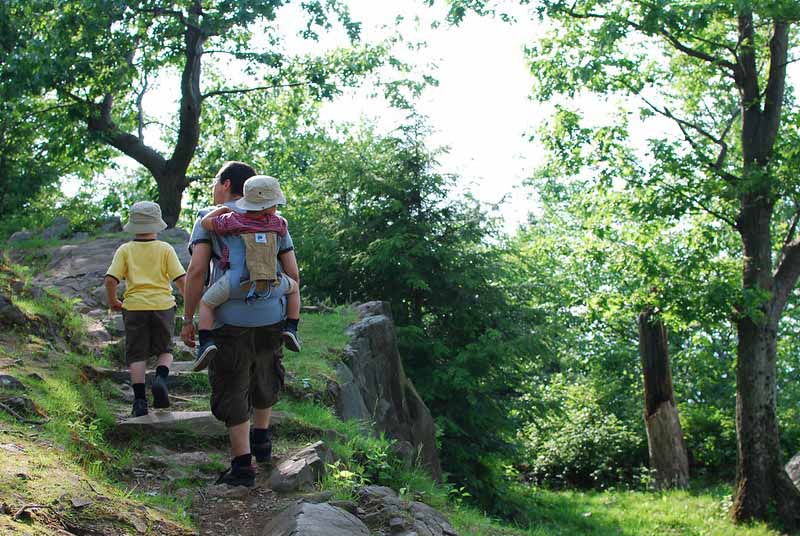
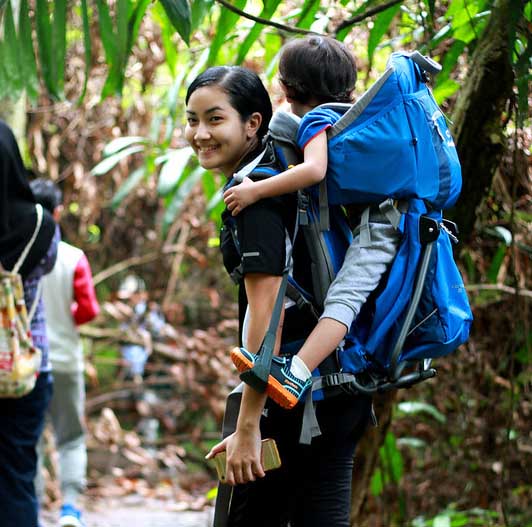
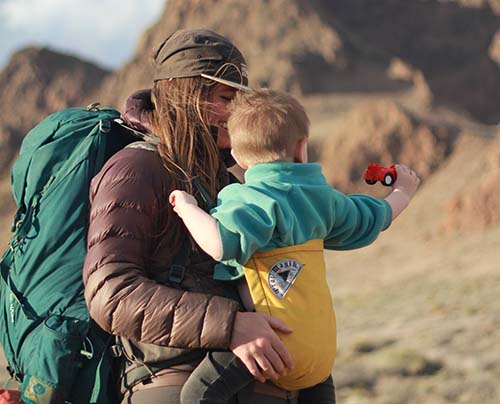
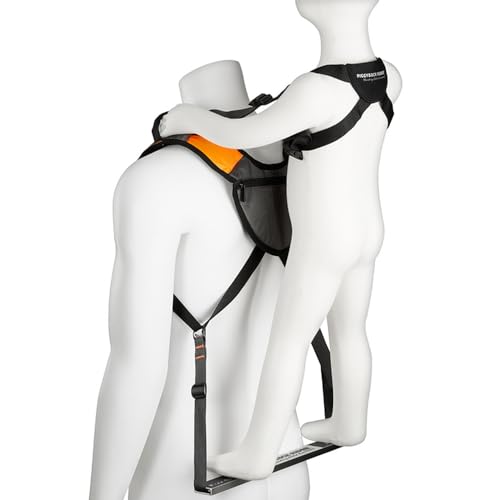
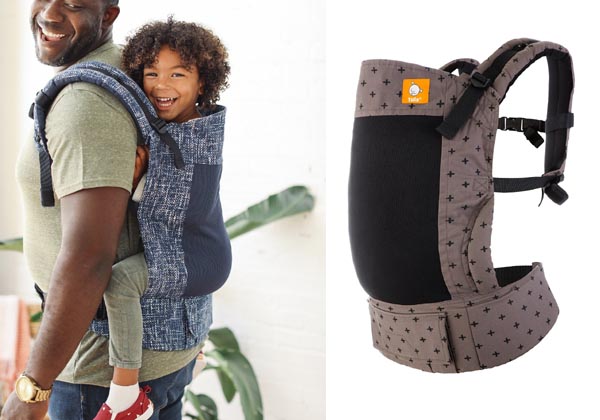

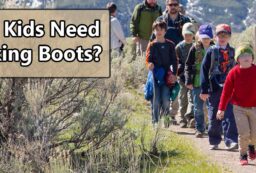
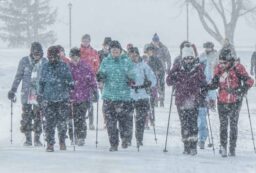







1 Comment
Jon
April 18, 2023 at 7:00 pmThis might work for my 30 lb french bulldog. Maybe legs sideways.